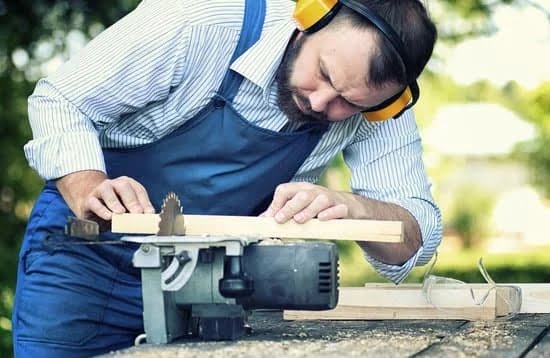Woodworking on a table saw requires understanding the significance of horsepower. The amount of power provided by the saw’s motor directly affects its ability to tackle different woodworking tasks effectively. Whether it’s cutting through thick hardwood or creating intricate designs, having the right amount of horsepower can make all the difference in achieving accurate and efficient results.
In this article, we will explore the basics of horsepower, factors to consider when choosing the right amount for your table saw, and how it influences safety and performance. With this knowledge, you’ll be able to make informed decisions that optimize your woodworking experience and ensure success in your projects.
Exploring the Basics
Table Saws are versatile tools widely used in woodworking, and understanding horsepower is crucial for selecting the best table saw for your projects. Horsepower (HP) is a unit of measurement that indicates the power output of a motor. In woodworking, horsepower determines the cutting capacity and performance of a table saw. It refers to the ability of the motor to generate torque, which translates into the saw’s cutting power.
When it comes to woodworking, having sufficient horsepower is essential for achieving smooth and efficient cuts. A higher horsepower allows the table saw to handle dense or thick materials with ease, while lower horsepower may struggle or bog down when cutting through these materials. Inadequate horsepower can result in slower cutting speeds, excessive strain on the motor, and potential damage to both the machine and your workpiece.
To determine how much horsepower you need for your table saw, consider various factors such as the types of projects you undertake, the thickness and density of wood you typically work with, and how frequently you use your table saw. A general guideline is that a minimum of 1-2 HP is suitable for light-duty tasks like hobbyist projects or occasional small woodworking tasks at home.
However, professional woodworkers or those who often work with hardwoods or thicker stock will benefit from more powerful motors ranging from 3-5 HP.
| Application | Recommended Horsepower Range |
|---|---|
| Home-based DIY Projects | 1-2 HP |
| General Woodworking & Furniture Making | 2-3 HP |
| Cabinet Making & Professional Woodworking | 3-5 HP |
Remember that horsepower alone should not be the sole criteria for choosing a table saw. Other factors such as blade quality, rip capacity, and safety features also contribute to the overall performance and functionality of a saw. It is important to strike a balance between horsepower, budget, and specific woodworking needs to ensure optimal cutting results while staying within your means.
Determining Your Woodworking Needs
When it comes to choosing the right horsepower for your table saw, it is essential to consider your woodworking needs. The amount of power you require will depend on the types of projects you typically work on and the materials you use. Here are some factors to consider when determining the horsepower for your table saw:
- Material Thickness: If you frequently work with thick and dense materials such as hardwoods or large sheet goods, you will need a table saw with higher horsepower. Thicker materials require more power to cut through them smoothly and efficiently.
- Project Complexity: The complexity of your woodworking projects can also influence the horsepower requirements. If you often tackle intricate designs that involve cutting curves or making bevel cuts, a higher horsepower saw will provide better control and precision.
- Frequency of Use: How often you use your table saw is another important factor to consider. If you are a professional woodworker who uses the table saw daily for long periods, investing in a higher horsepower model is recommended as it can handle continuous heavy-duty usage without straining the motor.
- Budget Constraints: While it may be tempting to choose the highest horsepower available, it’s important to consider your budget. Higher horsepower models are generally more expensive. However, there are options available that offer sufficient power at affordable prices if you don’t require extreme cutting capabilities.
It’s crucial to remember that while horsepower is an important factor in selecting a table saw, it’s not the sole determinant of performance. Other factors such as blade quality, fence system, and overall build quality also contribute to the overall efficiency and accuracy of a table saw. Thus, examining these aspects alongside horsepower considerations will help ensure optimal woodworking results.
In summary, determining your woodworking needs is vital when choosing the appropriate horsepower for a table saw. By considering factors such as material thickness, project complexity, frequency of use, and budget constraints, you can make an informed decision that aligns with your specific requirements.
Understanding the Power Options
In woodworking, the power of a table saw is determined by its horsepower. Understanding the different horsepower options available and their applications is crucial in making an informed decision when choosing a table saw for your specific woodworking needs.
Table saws typically range from 1 to 5 horsepower, with each option offering its own advantages and limitations. A lower horsepower may be sufficient for smaller, simpler projects, while a higher horsepower is necessary for larger, more complex tasks.
Let’s explore the different horsepower options and their applications in woodworking:
- 1 to 2 Horsepower: This range is ideal for small workshop environments or hobbyists who work on less demanding projects such as crafting small furniture pieces or making simple cuts on softer woods. Table saws with lower horsepower are generally lighter and more portable, making them easier to maneuver in tight spaces.
- 3 to 4 Horsepower: If you work on medium-sized projects or frequently cut denser hardwoods, a table saw within this range should be considered. The higher horsepower provides more cutting power and allows for smoother cuts through thicker materials. It also offers increased stability and durability, making it suitable for professional woodworkers who require a reliable machine for heavy-duty tasks.
- 5 Horsepower and Above: Table saws with this level of horsepower are designed for industrial-grade woodworking operations or highly specialized tasks that involve cutting massive timber or working with exotic hardwoods. These high-powered machines are capable of handling continuous heavy-duty use and offer exceptional precision and accuracy in cutting.
When selecting the right horsepower option for your woodworking needs, it’s essential to take into account the size of your workshop, the types of material you work with most frequently, and the complexity of your projects. Finding the right balance between power and practicality will ensure optimal performance without sacrificing efficiency or safety.
| Horsepower Range | Application |
|---|---|
| 1-2 Horsepower | Small workshop environments or hobbyists working on less demanding projects, such as crafting small furniture pieces or making simple cuts on softer woods. |
| 3-4 Horsepower | Medium-sized projects or cutting denser hardwoods. Suitable for professional woodworkers who require a reliable machine for heavy-duty tasks. |
| 5 Horsepower and Above | Industrial-grade woodworking operations or highly specialized tasks involving cutting massive timber or working with exotic hardwoods. |
Matching the Task at Hand
When it comes to woodworking on a table saw, choosing the right horsepower is crucial for ensuring efficient and successful projects. The horsepower of a table saw determines its power output, which directly affects its capability to cut through different types of wood and handle various woodworking tasks. In this section, we will explore how to evaluate and match the horsepower range of a table saw to specific woodworking projects.
Evaluating the appropriate horsepower range for a specific woodworking project requires considering several factors. One essential factor is the type of wood being worked with. Hardwoods typically require more power to cut through compared to softwoods. Additionally, the thickness of the wood should be taken into consideration. Thicker pieces may require a higher horsepower to make clean and accurate cuts.
The complexity of the woodworking task also plays a role in determining the suitable horsepower range. Simple tasks like making basic crosscuts or ripping thin boards may not require as much power as more intricate tasks such as cutting thick hardwoods at different angles or creating intricate joinery.
By evaluating both the type of wood and complexity of the task at hand, woodworkers can determine the optimal horsepower range that will provide sufficient power for their specific needs while avoiding overpowered or underpowered situations.
Performance vs Budget
Finding the optimal horsepower balance for woodworking on a table saw often comes down to a consideration of performance versus budget. It is essential to strike the right balance between the power needed for efficient work and staying within your financial means.
When it comes to performance, higher horsepower typically translates to greater cutting power and the ability to handle larger, more challenging materials. A table saw with ample horsepower can effortlessly cut through dense hardwoods and thicker stock with ease. It also allows for faster cutting speeds, which can significantly increase productivity in a woodworking shop.
On the other hand, budget constraints may limit your options when it comes to higher horsepower table saws. These models tend to be more expensive due to their advanced motor capabilities. However, that doesn’t mean you have to sacrifice performance altogether. There are still plenty of mid-range horsepower options available that offer sufficient power for most woodworking tasks without breaking the bank.
Importantly, when considering budget, it is crucial not to overlook factors such as durability and longevity. Investing in a high-quality table saw with sufficient horsepower can pay off in the long run by providing reliable performance and lasting durability, ultimately saving you money on repairs or replacements down the line.
Safety First
The safety of operating a table saw is of utmost importance in woodworking, and horsepower plays a crucial role in ensuring a safe working environment. The power generated by the motor directly affects the speed and efficiency at which the blade cuts through wood, but it also influences various safety aspects.
One key safety consideration is kickback, which occurs when a piece of wood gets caught in the blade’s teeth and forcefully ejected towards the operator. Higher horsepower allows for smoother and more consistent cutting, reducing the likelihood of kickback. This is because a higher-powered motor enables the blade to cut through material with less resistance, minimizing the chance of binding or catching.
Additionally, a more powerful motor ensures that the blade maintains its speed even when cutting denser or thicker materials. When using an underpowered table saw to cut through dense hardwoods or thick sheets of plywood, there can be instances where the blade slows down and potentially gets stuck. This can lead to accidents as it may cause wood to bind against the blade or increase the risk of kickback due to uneven cutting.
To ensure optimal safety while operating a table saw, it is essential to choose an appropriate horsepower based on your specific woodworking needs. Here are some factors to consider:
- Material Type: Different materials require different amounts of power. For example, cutting softwoods such as pine may require less horsepower compared to cutting hardwoods like oak.
- Cutting Depth: If you frequently work with deep cuts or thicker stock, opting for higher horsepower will provide more stability and prevent stalling.
- Frequency of Use: If you use your table saw extensively or for professional woodworking projects, a higher horsepower will help sustain performance over extended periods.
By considering these factors and selecting an adequate horsepower for your needs, you can ensure safer operation and reduce the risk of accidents while working with a table saw in woodworking projects.
The Practical Guide
Consider the Types of Wood and Projects You Will Be Working On
One important factor to consider when choosing the right horsepower for your woodworking needs is the type of wood you will be working with. Hardwoods, such as oak or maple, require more power to cut through compared to softer woods like pine or cedar.
Additionally, the size and complexity of your projects should also be taken into account. If you frequently work on larger-scale projects or need to make long, continuous cuts, opting for a higher horsepower table saw is recommended.
Assess Your Level of Expertise
Another important consideration when selecting horsepower for your table saw is your level of expertise in woodworking. If you are a beginner or only occasionally use a table saw for basic tasks, a lower horsepower option may suffice. However, if you are an experienced woodworker who frequently takes on challenging projects that require precision and consistency, investing in a higher horsepower table saw may be worth it.
Think about Portability and Space Limitations
Portability and space limitations are also factors that can impact your choice of horsepower for a table saw. If you have limited space in your workshop or need to regularly transport your table saw to different job sites, opting for a smaller, more compact table saw with lower horsepower might be the right choice.
On the other hand, if space is not an issue and you want a more robust and powerful table saw for heavy-duty woodworking tasks, a larger size with higher horsepower would be suitable.
By considering these practical tips and tricks when choosing the right horsepower for your woodworking needs, you can ensure that you have a table saw that meets both your project requirements and personal preferences. Remember that there is no one-size-fits-all solution when it comes to selecting horsepower for woodworking on a table saw – it ultimately depends on various factors unique to your situation.
Take the time to assess your needs, consider your resources and work environment, and make an informed decision that will enhance your woodworking efficiency and overall satisfaction with your chosen table saw.
Beyond Horsepower
When it comes to woodworking on a table saw, horsepower is undoubtedly an important factor to consider. However, there are also other factors that can greatly impact the efficiency and effectiveness of your woodworking projects. In this section, we will explore some of these additional factors and how they can contribute to enhanced woodworking efficiency on table saws.
Blade Quality and Sharpness
While horsepower provides the power needed to cut through wood, the quality and sharpness of the blade are equally crucial. A dull blade can lead to inefficient cutting, increased strain on the motor, and potentially unsafe operating conditions. It’s important to invest in high-quality blades that are suitable for your specific woodworking needs. Additionally, maintaining proper blade sharpness through regular sharpening or replacement is essential for optimal performance.
Saw Fence Alignment
The alignment of the table saw fence is another factor that can significantly impact woodworking efficiency. A misaligned fence can result in inaccurate cuts, wasted material, and potential safety hazards. Before beginning any project, it’s crucial to ensure that the fence is properly aligned parallel to the blade. Regular maintenance and adjustments should be done as needed to maintain accurate cuts and minimize waste.
Dust Collection System
Woodworking generates a considerable amount of dust and debris, which not only affects visibility but also poses health risks and can clog up your equipment. Investing in a reliable dust collection system is essential for keeping your workspace clean and ensuring efficient operation of your table saw. Proper dust collection prevents dust buildup on the blade and motor, reducing wear and tear on components while also promoting a healthier working environment.
Material Support
Having adequate material support when using a table saw is crucial for safe and efficient woodworking. Insufficient support can cause materials to sag or tip during cutting, leading to inaccurate cuts or potential accidents. Consider using auxiliary supports such as roller stands or outfeed tables to provide stability and prevent materials from moving during the cutting process.
While horsepower is a crucial consideration, it’s important to keep in mind these additional factors for enhanced woodworking efficiency on table saws. By paying attention to blade quality and sharpness, saw fence alignment, dust collection, and material support, you can ensure not only optimal performance but also a safer and more enjoyable woodworking experience.
Final Thoughts
In conclusion, understanding the importance of horsepower in woodworking on table saws is crucial for achieving woodworking success. Horsepower is a measure of power and determines the performance and efficiency of a table saw. It is important to explore the basics of horsepower and why it matters in woodworking to make an informed decision.
When determining your woodworking needs, there are several factors to consider when choosing horsepower for a table saw. These factors include the type of wood you work with, the size and complexity of your projects, and the frequency of use. It is essential to understand the different horsepower options available and their applications in woodworking. Matching the task at hand with the suitable horsepower range ensures optimal performance and prevents potential setbacks.
Performance versus budget is another important consideration when choosing horsepower for woodworking on table saws. It is necessary to find an optimal balance between performance and cost that meets your specific needs and budget constraints. Additionally, safety should always be a primary concern when operating table saws for woodworking. The right amount of horsepower can influence the safety aspects by ensuring smooth cutting without straining the motor or risking kickback.
Frequently Asked Questions
What horsepower table saw do I need?
The horsepower of a table saw determines its cutting performance and capacity. The appropriate horsepower for a table saw primarily depends on the type of work you intend to do with it. For general woodworking tasks like cutting boards, 1-2 horsepower is usually sufficient.
However, if you frequently work with thicker or harder materials, such as hardwood or plywood, a more powerful saw with 3-5 horsepower would be beneficial. A higher horsepower allows the saw to maintain consistent blade speeds even when encountering tougher materials, resulting in smoother cuts and less strain on the motor.
How powerful should a table saw be?
The power of a table saw is an important consideration when determining its suitability for your needs. Higher-powered saws can handle heavy-duty cutting tasks more efficiently and effectively than lower-powered ones. However, it’s essential to balance power with your intended usage.
If you are a hobbyist or primarily engage in light-duty projects, a less powerful table saw would be suitable and cost-effective. On the other hand, if you frequently tackle large-scale projects or significant woodworking tasks professionally, investing in a high-powered saw would provide enhanced productivity and durability.
Is 5 hp too much for table saw?
Whether 5 horsepower is too much for a table saw depends on several factors such as the scale of your woodworking projects and your budget constraints. While 5 horsepower can deliver substantial cutting power for heavy-duty applications, it may not be necessary for everyone. This level of power is most commonly found in industrial-grade table saws employed by professional woodworkers or production shops handling large-scale projects or commercial operations regularly working with dense materials like hardwoods or metals that demand significant cutting force.
As a result, the average hobbyist or DIY enthusiast may find that investing in this level of horsepower exceeds their requirements and budgetary considerations while offering limited additional benefits compared to lower powered models available on the market. Ultimately, it’s crucial to assess your specific needs and choose a table saw that provides adequate power without unnecessary excess for your intended applications.

Hi everyone! I’m a woodworker and blogger, and this is my woodworking blog. In my blog, I share tips and tricks for woodworkers of all skill levels, as well as project ideas that you can try yourself.





